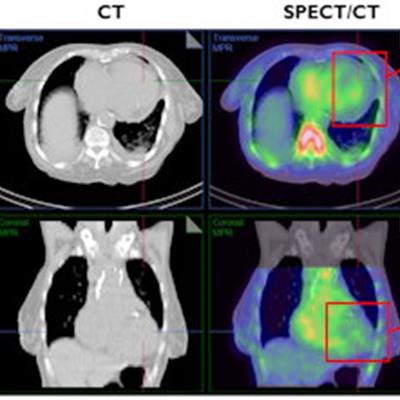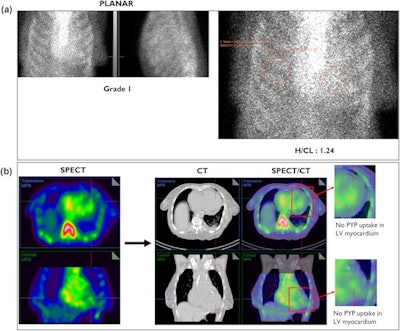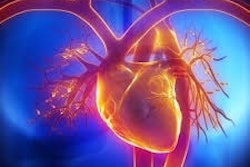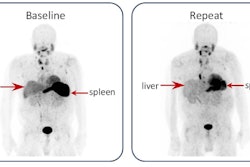
SPECT/CT fusion imaging offers significant advantages over SPECT alone for imaging cardiac amyloidosis by reducing false positives, according to a study published March 1 in the Journal of Nuclear Cardiology.
A group led by Dr. Zainab Al Taha of Sheikh Shakhboot Medical City in Abu Dhabi, the United Arab Emirates, compared the approaches in a three-year imaging quality improvement project. They found the addition of SPECT/CT eliminated all false-positive studies.
"We propose that where the resources are available, SPECT/CT fusion should be the standard of care imaging due to its highly effective impact in sensitivity and specificity and overall diagnostic accuracy," Al Taha and colleagues wrote.
Cardiac amyloidosis (also called "stiff heart syndrome") is a progressive disease in which amyloid deposits composed of misfolded protein take the place of normal heart muscle. This impedes the heart muscle's ability to pump efficiently and can lead to heart failure.
Planar and SPECT nuclear imaging techniques using cardiac radiotracer (technetium-99m pyrophosphate) are standard approaches for diagnosing the disease, yet are limited by an "Achilles heel," according to the researchers -- namely, excessive blood pool uptake in the heart's left ventricular (LV) cavity that impairs the display of the tracer in the imaging and invariably leads to high percentages of false positive or equivocal studies.
 (A) Three-hour planar imaging interpreted as "equivocal for ATTR amyloidosis." Visual assessment of planar images further demonstrates relatively less myocardial uptake compared with the ribs. (B) SPECT alone demonstrates an empty-looking left ventricular (LV) cavity, which is shown to be the thickened septal wall on the fused CT images. Also note that the inferior lateral border of the LV wall is not demonstrating any radiotracer uptake with SPECT/CT fusion. SPECT/CT reclassifies the case from equivocal to "not suggestive." Image and caption courtesy of the Journal of Nuclear Cardiology through CC BY 4.0.
(A) Three-hour planar imaging interpreted as "equivocal for ATTR amyloidosis." Visual assessment of planar images further demonstrates relatively less myocardial uptake compared with the ribs. (B) SPECT alone demonstrates an empty-looking left ventricular (LV) cavity, which is shown to be the thickened septal wall on the fused CT images. Also note that the inferior lateral border of the LV wall is not demonstrating any radiotracer uptake with SPECT/CT fusion. SPECT/CT reclassifies the case from equivocal to "not suggestive." Image and caption courtesy of the Journal of Nuclear Cardiology through CC BY 4.0.For the study, the researchers hypothesized that the addition of anatomical CT imaging to SPECT could reduce numbers of equivocal and false positive results and thus improve diagnostic accuracy in patients. The group conducted an analysis of imaging in 176 patients with cardiac amyloidosis; of the total patient cohort, there were 35 equivocal cases, 32 "strongly suggestive" cases, and 109 that did not indicate disease. All patients were imaged using a hybrid SPECT/CT scanner.
For patients who initially underwent SPECT only, the addition of SPECT/CT fusion resulted in a reclassification of 73% of cases. The team also found the following:
- 100% of equivocal cases were reclassified to not suggestive or "strongly suggestive."
- 73% of strongly suggestive cases were reclassified to not suggestive; eight "strongly suggestive" cases were confirmed to be true positives.
- 13 not suggestive cases remained negative after patients underwent an SPECT/CT fusion exam.
The authors also found that in cases where SPECT/CT fusion was used from the beginning, there was no reclassification of any of the cases when these cases were reprocessed as a control group.
"Addition of SPECT/CT imaging reduces the false positive or equivocal studies and increases the diagnostic accuracy of the test," they reported.





















